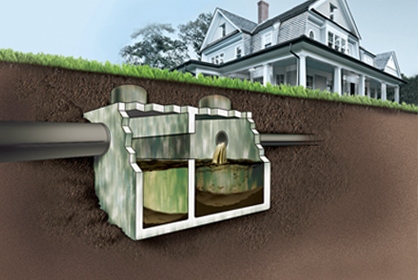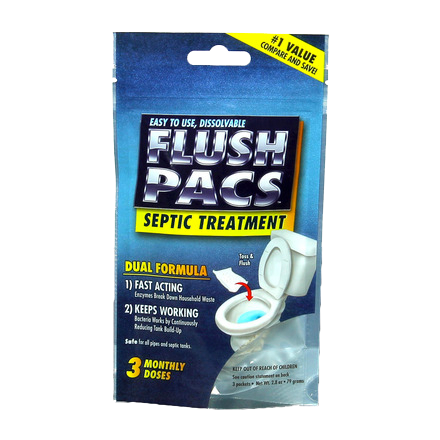How Septic Systems Work

If you have a septic system, all water that is utilized within your home drains into your septic tank. Some drainage is simply water from doing laundry or from washing your hands and some water contains waste from toilet flushing or running the disposal.
Once the wastewater enters the septic tank it will begin to separate. The waste that rises to the top of the tank, generally smaller particulate, will flow from the outlet pipe and into the lateral lines. Lateral lines (usually 3) are PVC pipes that contain holes throughout the run of pipe. The wastewater is then “leached” into the bed of rock and sand underneath the lines and back into the soil or “leach field” for underground dispersal. The larger remaining waste stays trapped in the tank.
Septic tanks may or may not contain a baffle. A baffle is designed to block larger waste from entering the lateral lines. If your tank was installed before 1990, your tank probably does not have an outlet baffle. As you might imagine, tanks without a baffle are often clogged and do not allow for efficient leaching into the lateral lines. This can cause sewage back-ups into your home and standing pools of water where the septic tank is installed in your yard. Newer systems now have a baffle installed to keep this from occurring.
Potential Causes Of Septic System Failures
Here are some potential reasons your system may begin to fail:
- Large trees are planted near or over the system – roots may cause a problem
- Abnormally rainy season
- The system is older and does not contain a baffle or has other design issues
- The system is to small for the number of uses in the home
- Excessive use of chemicals, soaps, greases and cleaning agents
As a septic system begins to fail, you will notice a slight odor coming from toilets and drains that become stronger overtime. You will also notice that when flushing the toilet it will gurgle or gasp. When a septic tank begins to pool, it is not always noticeable because septic systems are a substantial distance from the home. When mowing in the septic area, look for significant greening or any soggy areas. These are sure signs of system failure.
Maintaining Your Septic System

As with any internal/external system in the home your septic system needs regular maintenance. Septic systems are easy to forget because they are outside and very often become “out of sight, out of mind”. Pumping can cost anywhere from $500 – $1,000 depending on where you live and system repair can cost as much as $6,000. One of the most important measures you can take as a homeowner is to treat your septic system monthly with a strong bacteria and enzyme treatment. Using a natural septic tank treatment like FlushPACS™ can help prevent yearly pumping and keep malfunctions from occurring for as little as $26.00 per year. That is the cheapest safeguard you will ever buy for your home!
FlushPACS™ Feature:
- A fast acting, natural formula made of bacteria that continuously multiply & work to remove wastes
- Three enzymes to break down household waste without damaging plumbing
- #1 Value compared to other 6 month treatments
- Low investment cost of only $26.00 for one year’s worth of treatment
- Easy to use, one packet per month maintenance
- Prevention against costly septic system backups and repairs*
*along with regular pumping
FlushPACS™ bacteria and enzyme treatments break down organic wastes, toilet paper, greases and surfactants via a process known as bio-augmentation. This is the process by which natural bacteria and enzymes utilize these wastes and waste by-products as food sources. The enzymes found in FlushPACS™ work like saliva to start the degradation of larger wastes in the system. As the wastes are “eaten” bacteria liquefy and remove those wastes allowing for an easier flow out into the lateral lines. The result is a cleaner, free flowing system that significantly reduces back-ups, mechanical pumping and system malfunction.